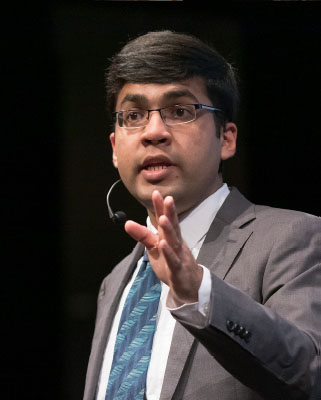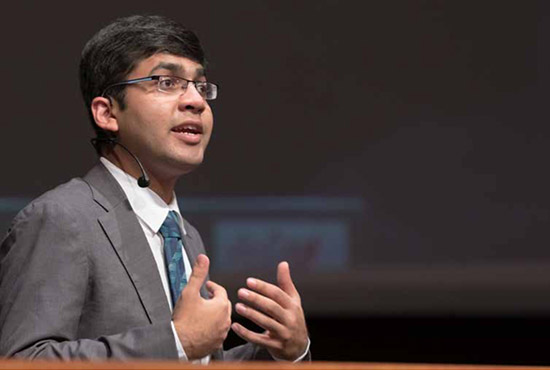


バネルジー・トリシットさん
Mr. Banerjee Trishit
東北大学大学院 理学研究科 化学専攻 1年
Good afternoon everybody. What do you think this number represents? It represents the number of working holiday visas issued by Japan in 2014. But, what do you think this number represents? This number represents the number of working holiday visas issued to the Japanese in the same year. Clearly, there are more people leaving Japan than entering under this visa program.
Over the last 40 years, the Japanese government has signed working holiday agreements with 23 different countries out of which 22 have been classified as high income economies by the World Bank. So, it is safe to assume that people from these countries would not really think of moving abroad for a job only for the sake of money. If we want to attract them to Japan we have to provide them something more than money.
Allow me to take you 200 kilometers north from Tokyo to the coastal prefecture of Fukushima with a population of 1.84 million people. It is famous for its delicious Kitakata Ramen, the Edo-style thatched roof housing in Ouchi-juku and the Papier-mâché Akabeko. Believe me, it is one of the best places I have been to in Japan.

But, what do you find when you search for Fukushima on the internet? It is this, the 2011 nuclear disaster. All the beauty and charm of Fukushima is lost in this. Tourism numbers fell down to a record low. More and more locals started moving out of Fukushima to bigger cities like Tokyo and Sendai. Between 2014 and 2019 even the Japanese working age population shrank by more than 4 million people and thus making recovery in disaster affected areas very difficult.
So, let me ask you a question, what percentage of companies in Fukushima do you think reported labor shortage after 2011? More than 20%? More than 50%? More than 70%? The answer is 70.5%. Shocking, right? It is at this moment I wondered if there is a way to promote the working holiday visa program but at the same time mitigate the challenge of labor shortage and revitalization of the disaster affected region.
At that time I conceived the idea ‘Fukushima from you’. This program is divided in four stages or four P’s as I like to call it; promotion, preparation, prosecution or execution, and propagation.
At first, how do we reach out to the foreigners about this program? We can contact the local travel agencies, the consulate generals and embassies of Japan where working holiday agreements already exist. We can also reach out to the local high school and universities to attract the young people between the ages 18 and 25. In fact, when the Fukushima government used these two channels; they could attract 3000 more Australian tourists in one single year for its ski program.
Finally, we would use the JET Alumni Network for promotion. The JET Program is actually a great program as so many foreigners have come to Japan and taught English in schools. But, a lot of these foreigners are not really trained in education and teaching. Under our initiative, they can choose a work where they are already skilled at and get both experience and money.
The next is preparation. Once they arrive in Japan they really have to face the problem of communication. At that time we really need to provide them with some Japanese language training. We would give them 100 hours of Japanese language training : 4 hours a day over 25 days spread over 2 months. The applicants can actually choose the classes depending on their Japanese levels. The total cost of this would be ¥70,000 per applicant.
Next is the ‘dream tour’ where we would take the applicants to companies which are facing labor shortage and also to those companies which were established after 2011 as a sign of economic recovery in Fukushima. If the company chooses the applicant and the applicant also chooses the company, the company can pay us a referral fee and the applicant can pay us ¥20,000 for the matching process.
Finally, there is ‘My Fukushima’ initiative which focuses solely on holiday aspect of the visa. We will be organizing cultural events such as calligraphy, kokeshi doll making, akabeko doll painting, etc. We would also find opportunities for these foreigners to participate in local festivals as the local festivals too are in the crisis since many locals are moving out of the small towns and villages. In this way, we can help in preserving the culture and heritage of the small areas.

We would also have networking events where the foreigners would be able to meet company executives regularly so that they can plan out the future long term career in Japan after the visa ends. All of this, these three together would cost ¥120,000 per applicant. But do you know what is the good point? They do not have to pay anything, absolutely nothing until they start working on the job.
Now you would be asking what job? Where will they live? What kind of work would they do? We will also assist in finding apartments and garages. Actually I spoke to some real estate agents in Fukushima who told me that the living cost in Fukushima is ¥85,000 per month. The potential companies I spoke to said that an 8-hour job for 40 hours on weekdays can get a local holiday worker ¥120,000 per month. That means in the 10-month period the applicant can actually save up to ¥300,000 which is enough to pay for our expenses, their flight tickets, and their own personal expenses.
On the weekends they can have the cultural activities, tourism, and networking events. They can work in fruit orchards like this. They can plant, grow, and harvest some of Fukushima’s most delicious fruits; apples, cherries, and peaches. Or, they can work in the hospitality sector they can Tsuchiyu Onsen where they can work as cleaning staff, kitchen staff or reception staff. These places of popular tourism can be converted to places of potential employment because both these areas are facing a labor shortage as younger Japanese do not want to work in remote areas for longer periods of time.
Now you would be wondering are foreigners actually okay with this idea? So, I conducted a survey with 80 different foreigners and I spoke to them. So, 56% of them said they would like to work in a smaller town which would give them a contribution sense to the disaster affected community over a larger town which gives them only a higher salary. But when I asked them would you work in Fukushima they said, only 23% actually agreed to it.
So, that is when I put the proposal that if there is a program like Fukushima From You initiative to actually assist you and a dedicated initiative to help you would you now go to Fukushima? And, the numbers doubled to 48%. I also spoke to the locals. Actually the people at the Marusei Orchard and Tsuchiyu Onsen are very optimistic that such an idea would invite more foreigners to come to Japan, work, and live. I also spoke to the Fukushima city and prefectural government. They are also optimistic that such initiative would help in attracting more foreigners to work in Fukushima.
This brings us near to the end, the propagation because it just doesn’t stop in Fukushima. It can be translated to other disaster affected regions such as the recent typhoon Hagibis in Chiba or the Kumamoto earthquake in 2016. Such initiative would help in creating economic recovery and at the same time will provide a sense of purpose and fulfillment to the foreigners working there.
It is a win-win situation for both. For the foreigners they can get job experience. They can earn money, save it. They can learn a new language, culture and also they can get a sense of purpose for contributing to the economy and the community. For Fukushima they can get agents to mitigate the effects of the disaster. It’s a chance for them to multi-culturalize and internationalize and importantly to create a positive image about this beautiful prefecture in the global community.
It is very well known that when an employee in any places starts thinking that their work would actually bring a positive change on the community they would be more self-motivated to work on it because that is the essence of our living. We can only rise by lifting others. And, Fukushima is the only – the first step in this entire process. Thank you so much.

皆さんこんにちは。この数字は何を表していると思いますか。2014年に日本で発行されたワーキングホリデービザの数を表しています。しかし、(別の数を指す)この数字は何を表していると思いますか。同じ年に日本人に向けて発行されたワーキングホリデービザの数を表しています。このビザ制度で海外から入国してくる人たちよりも、日本を離れていく人たちのほうが多いということが明らかです。
40年以上にわたって日本政府は23ヵ国とワーキングホリデー協定を結び、そのうちの22ヵ国は世界銀行に高所得経済と分類された国です。そのため、それら協定国からの人々は、金銭だけが目的で海外に仕事に出ることはないだろうと想定できるので安心です。もし私たちがその人たちを日本に引き付けたいのならば、金銭以上の何かを提供しなければいけません。
皆さんをここ東京から200km北に離れた、沿岸沿いの人口184万人の福島県に連れて行かせてください。福島県は美味しい喜多方ラーメンや、茅葺屋根の集落「大内宿」や張子皿です。福島県は、私が日本で訪れた中で最高な場所の一つです。
しかし、インターネットで「福島」と調べると何が見つかるのでしょうか。それは、2011年に起きた原子力災害です。この災害によって福島の美しさや魅力は全て失われてしまいました。観光客の数も過去最低にまで落ち込みました。地元の人もますます福島から、東京や仙台のような大都市に移り住み始めました。2014年から2019年の間には日本の労働人口も4百万人減少しました。
一つ皆さんに質問させてください。2011年以降、福島にある会社内のどのくらいが人手不足であると報告したと思いますか?2割以上?5割以上?7割以上?答えは7.5割です。衝撃的ですよね?その瞬間(これを知った瞬間)ワーキングホリデービザを促進させる方法はあるのか疑問に思い、同時に労働力不足の困難を軽減し、災害の被害が及んだ地域の再生する方法もないのかと考えました。
その時、「福島」のアイデアを確信しました。 このプログラムは4つのステージ、または私がやりたかった4つのことに分けられます。それは「プロモーション」、「準備」、「実行または達成」、「宣伝」です。
まず初めに、このプログラムをどのようにして外国の方々に知らせるのでしょうか。地元の旅行会社や、領事館の総領事たちや、既にワーキングホリデー協定を結んでいる大使館とコンタクトをとることが考えられます。さらに、18歳から25歳までの若者を引き付けるために、地元の高校や大学とも連絡を取ることも考えられます。実際に福島県がこの二つの手段を使ったとき、プログラムのおかげで、たった一年で3000人以上のオーストラリア人観光客を呼び込むことができました。
最後に、「プロモーション」のためには日本交流教育(JET)プログラムを使うでしょう。JETプログラムはこれまでにたくさんの外国の方々が日本に来て学校で英語を教えてくれた素晴らしいプログラムです。しかしながら、そのうちの多くは教育を教えるためによく訓練されていたわけではありません。日本の新たな試みのもと、彼らはすでに経験のある仕事を選ぶことができ、経験もお金も両方得ることができます。
次に「準備」です。日本につくとすぐに彼らはコミュニケーションの問題に直面します。その時に彼らに日本語のトレーニングを提供する必要があります。私たちは100時間の日本語のトレーニングを提供するでしょう。このトレーニングは二か月にわたり一日4時間、25日以上です。志願者は日本語レベルによってクラスを選べます。料金は志願者一人につき合計7万円になります。
次は志願者たちを人手不足に直面し、かつ2011年以降に福島県で経済回復の象徴として設立された会社につれていく「ドリームツアー」についてです。もし会社が志願者を選び、志願者もまたその会社を希望すれば、その会社は仲介者に紹介料を払い、志願者は2対1のマッチングに2万円払います。
最後に、ワーキングホリデービザ単独に焦点を当てる「私の福島の構想」があります。書道やこけしづくり、かみこ人形塗りのような文化的イベントを作ります。また海外の方が地元のお祭りに参加できるような、機会を見つけることもできます。なぜなら地元のお祭りもまた、小さな町や村から人が出て行ってしまっているという危機にあるからです。この構想で、文化や小さな地域の伝統を保護することを手伝うことができます。
また外国の方々が会社の重役たちと定期的に会うことのできるネットワーキングサービスもあり、それによって彼らはビザが終了した後、日本での長期的な将来の仕事を綿密に計画することができます。これら三つをすべて合わせると一人当たり12万円かかります。しかし、この良いポイントは何か知っていますか?それは彼らが仕事を始めるまで、自分で一切支払う必要はないということです。
皆さん、それは一体何の仕事なのか聞きたくなりましたか。彼らはどこに住むのか。どんな仕事をするのか。私たちはアパートや車庫を見つけることも伝うのか。実をいうと、福島に住むには月8万5千円かかると、不動産業者に教えてもらったことがあります。私が話した見込みのある会社は、1日8時間の仕事を40時間(週5日)行うことで、現地のホリデーワーカーは月に12万円得ることができると話しました。これは10ヵ月間働けば、私たちの費用や、彼らの航空券、彼らの個人的な出費を支払うにも十分な30万円を貯めることができます。
彼らは週末には文化活動をしたり観光をしたり、ネットワーキングイベントに参加したりすることができます。果樹園で働くこともできます。リンゴやサクランボや桃など、福島の代表的なおいしいフルーツを植え、育て、収穫することができます。または、おもてなしの分野で清掃員や厨房や受付スタッフとして土湯温泉(福島市)で働くこともできます。これらの人気の観光地には、雇用の可能性があります。なぜなら人里離れた地域で日本の若者は、長期間働きたがらないので、人手不足に直面しているからです。
皆さんは今、外国の方々がこの案で本当に良いと思うのか気になっていることでしょう。ですから80ヵ国の人々に調査をし、話してみました。すると56%の人が、高い給料を得られる大都市よりも、被災した地域に貢献できる小さな町で働きたいと答えました。しかし、福島県で働きたいかと聞くとそれには23%しか働きたいと答えませんでした。
そこで、「Fukushima From You」のようなプログラムを提案して再度福島県で働きたいかと質問すると数字は倍の48%にまでなりました。地元の人にもまた話をしました。土湯温泉の人たちは実際に、そのようなプログラムはより多くの海外の方々が日本を訪れ、仕事をし、住むことを促進することになるだろうとアイデアに肯定的でした。私はまた福島市と県政とも話しました。彼らもまた、そのような計画は福島で働くより多くの外国の方々を引き付けることになるだろうと肯定的でした。
「宣伝」は終わりに近づいています。なぜなら福島だけで止まるものではないからです。それは千葉に被害を与えた台風ハギビスや2016年に起きた熊本震災などの災害にも応用できます。そのような提案は経済回復を助け、同時にそこで働く外国の方々に目的と満足感を与えるでしょう。
これは双方にとってウィンウィンな状況なのです。外国人労働者は仕事経験を得ることができ、金銭も得ることも貯金もできます。新しい言語や文化を学ぶこともでき、また経済やコミュニティーへ貢献することの目的も得られます。福島県は災害の被害を緩和するために労働力を獲得することができます。これは多文化化や国際化するチャンスであり、大切なことはグローバルな地域社会の中で、この美しい県のプラスのイメージを作り上げるということです。
従業員が、彼らの仕事がその地域社会にプラスのイメージをもたらしていると考えることは、仕事に対するモチベーションの向上につながるということはよく知られています。なぜなら、それは私たちの生活の本質であるからです。私たちは、他者を高めることによってのみ、向上することができます。そして福島はたったひとつの、この全てのプロセスの最初のステップなのです。ご清聴ありがとうございました。